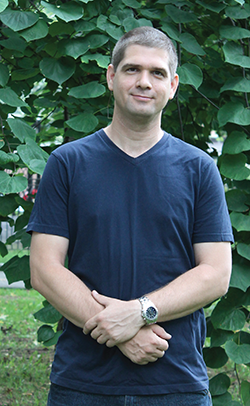Dr. Ran Budnik is part of an international team of scientists creating new instruments they hope will show the first confirmed interactions between so-called “dark matter” and “normal,” baryonic, matter.

Dr. Ran Budnik
Dark matter is one of the most striking unsolved mysteries in physics today. Scientists have yet to detect it directly, but almost all measurements of the motion of galaxies, the evolution of the universe, and the behavior of matter in the known universe have led scientists to believe that there must be a tremendous amount of mass in the universe that is not made of conventional matter.
One of the leading theories about the nature of dark matter is that it consists of weakly interacting massive particles (dubbed WIMPs) that contain far more mass than protons and neutrons, but that rarely interact with conventional matter. They give off no light or electromagnetic radiation, but are affected by gravity. Scientists believe that a promising way to detect WIMPs is by looking for evidence of them colliding with the nuclei of visible matter. This is where Dr. Budnik joins the search. He worked on radiation detectors during his postdoctoral research at the Weizmann Institute, and for the past three years he has analyzed data taken by the XENON100 experiment.
To be able to isolate the experiment from almost all other possible interactions, the XENON100 international research team works deep underground at the Gran Sasso National Laboratory (LNGS), built next to a highway tunnel under a mountain near Rome. They are using a super-cooled vat of 100 kilograms of liquid xenon surrounded by an array of photon detectors, inside an electric-field cage that allows a 3D reconstruction of each interaction. Collisions between WIMPs and the nuclei of conventional matter are expected to be very rare events, given the extremely weak interaction strength. However, liquid xenon has several properties that make it a promising medium for detecting these collisions: It is free of impurities, has no long-lived radioactive isotopes, and emits two simultaneous signals following a collision: a photon of light and a charged electron. Dr. Budnik tackles the difficult task of trying to match the detection of the photons by the array of photon detectors, with the signature of a charge of electrons reaching the liquid xenon surface, where they are accelerated and emit a second pulse of photons.
For the planned detector XENON1T, Dr. Budnik is helping design and build the cryogenic systems that will keep the instruments cool and working at the low temperatures needed for the liquefaction and maintenance of 3.5 tons of liquid xenon. This experiment will be submerged in a water bath containing instruments being designed at the Weizmann Institute. The new detector is expected to be about100 times more sensitive than the current XENON100 system. Dr. Budnik is also the lead scientist on a test project, the XENON1T demonstrator, that is a full-scale prototype of the new 1-ton system; the demonstrator project must prove the possibility of measuring the ionization signal of electrons “drifting” up to a meter from the site of the collision to the surface of the xenon. Only after the demonstrator succeeds in its mission could scientists give the green light to building the next-generation XENON1T system.
Dr. Budnik aims to be an integral part of the worldwide scientific efforts to discover evidence of dark matter through the conclusion of the XENON100 project, building and operating the next-generation XENON1T, and the planned DARWIN international project to build multi-ton-scale liquid xenon and argon detectors. He will combine small-scale, proof-of-concept experiments built at the Weizmann Institute in cooperation with the large international coalitions.
Dr. Ran Budnik
Dr. Ran Budnik completed his BSc in physics and mathematics in the elite Israel Defense Forces (IDF) Talpiot training program at the Hebrew University of Jerusalem in 1997. From 1994 to 2004, he served as a cadet and then as a research scientist in the IDF. He was awarded his MSc by the Technion-Israel Institute of Technology in2004, and his PhD in physics by the Weizmann Institute of Science in 2009, spending the next year as a postdoctoral fellow at Weizmann. From 2010 until joining the Weizmann Institute in 2013, he was a postdoctoral fellow at Columbia University working on the XENON dark-matter project.
Dr. Budnik won first place in the Israel Physics Olympics in 1994 and went on to win a silver medal in theoretical physics at the International Physics Olympics that year. He was on the Dean’s List at Hebrew University in 1995. Dr. Budnik was commander of the third-year students in the IDF Talpiot program in 2000–2001, and completed his service at the rank of major.
